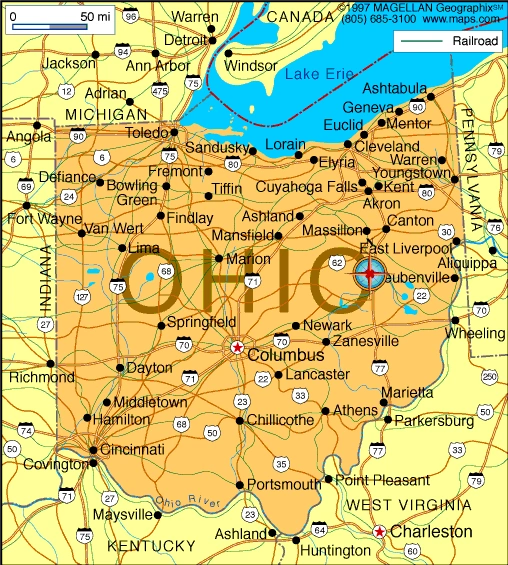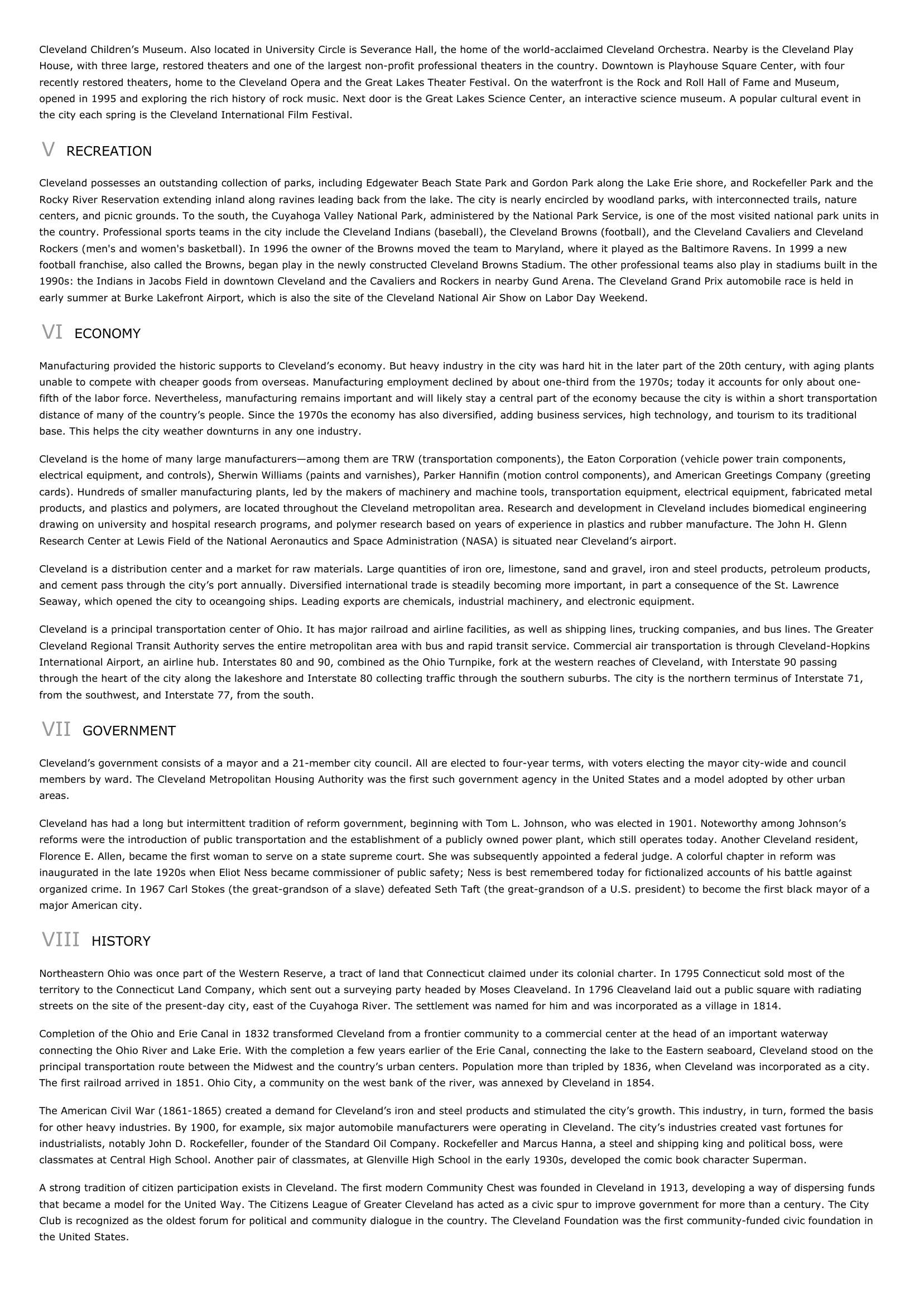Cleveland (Ohio) - geography.
Publié le 04/05/2013

Extrait du document


«
Cleveland Children’s Museum.
Also located in University Circle is Severance Hall, the home of the world-acclaimed Cleveland Orchestra.
Nearby is the Cleveland PlayHouse, with three large, restored theaters and one of the largest non-profit professional theaters in the country.
Downtown is Playhouse Square Center, with fourrecently restored theaters, home to the Cleveland Opera and the Great Lakes Theater Festival.
On the waterfront is the Rock and Roll Hall of Fame and Museum,opened in 1995 and exploring the rich history of rock music.
Next door is the Great Lakes Science Center, an interactive science museum.
A popular cultural event inthe city each spring is the Cleveland International Film Festival.
V RECREATION
Cleveland possesses an outstanding collection of parks, including Edgewater Beach State Park and Gordon Park along the Lake Erie shore, and Rockefeller Park and theRocky River Reservation extending inland along ravines leading back from the lake.
The city is nearly encircled by woodland parks, with interconnected trails, naturecenters, and picnic grounds.
To the south, the Cuyahoga Valley National Park, administered by the National Park Service, is one of the most visited national park units inthe country.
Professional sports teams in the city include the Cleveland Indians (baseball), the Cleveland Browns (football), and the Cleveland Cavaliers and ClevelandRockers (men's and women's basketball).
In 1996 the owner of the Browns moved the team to Maryland, where it played as the Baltimore Ravens.
In 1999 a newfootball franchise, also called the Browns, began play in the newly constructed Cleveland Browns Stadium.
The other professional teams also play in stadiums built in the1990s: the Indians in Jacobs Field in downtown Cleveland and the Cavaliers and Rockers in nearby Gund Arena.
The Cleveland Grand Prix automobile race is held inearly summer at Burke Lakefront Airport, which is also the site of the Cleveland National Air Show on Labor Day Weekend.
VI ECONOMY
Manufacturing provided the historic supports to Cleveland’s economy.
But heavy industry in the city was hard hit in the later part of the 20th century, with aging plantsunable to compete with cheaper goods from overseas.
Manufacturing employment declined by about one-third from the 1970s; today it accounts for only about one-fifth of the labor force.
Nevertheless, manufacturing remains important and will likely stay a central part of the economy because the city is within a short transportationdistance of many of the country’s people.
Since the 1970s the economy has also diversified, adding business services, high technology, and tourism to its traditionalbase.
This helps the city weather downturns in any one industry.
Cleveland is the home of many large manufacturers—among them are TRW (transportation components), the Eaton Corporation (vehicle power train components,electrical equipment, and controls), Sherwin Williams (paints and varnishes), Parker Hannifin (motion control components), and American Greetings Company (greetingcards).
Hundreds of smaller manufacturing plants, led by the makers of machinery and machine tools, transportation equipment, electrical equipment, fabricated metalproducts, and plastics and polymers, are located throughout the Cleveland metropolitan area.
Research and development in Cleveland includes biomedical engineeringdrawing on university and hospital research programs, and polymer research based on years of experience in plastics and rubber manufacture.
The John H.
GlennResearch Center at Lewis Field of the National Aeronautics and Space Administration (NASA) is situated near Cleveland’s airport.
Cleveland is a distribution center and a market for raw materials.
Large quantities of iron ore, limestone, sand and gravel, iron and steel products, petroleum products,and cement pass through the city’s port annually.
Diversified international trade is steadily becoming more important, in part a consequence of the St.
LawrenceSeaway, which opened the city to oceangoing ships.
Leading exports are chemicals, industrial machinery, and electronic equipment.
Cleveland is a principal transportation center of Ohio.
It has major railroad and airline facilities, as well as shipping lines, trucking companies, and bus lines.
The GreaterCleveland Regional Transit Authority serves the entire metropolitan area with bus and rapid transit service.
Commercial air transportation is through Cleveland-HopkinsInternational Airport, an airline hub.
Interstates 80 and 90, combined as the Ohio Turnpike, fork at the western reaches of Cleveland, with Interstate 90 passingthrough the heart of the city along the lakeshore and Interstate 80 collecting traffic through the southern suburbs.
The city is the northern terminus of Interstate 71,from the southwest, and Interstate 77, from the south.
VII GOVERNMENT
Cleveland’s government consists of a mayor and a 21-member city council.
All are elected to four-year terms, with voters electing the mayor city-wide and councilmembers by ward.
The Cleveland Metropolitan Housing Authority was the first such government agency in the United States and a model adopted by other urbanareas.
Cleveland has had a long but intermittent tradition of reform government, beginning with Tom L.
Johnson, who was elected in 1901.
Noteworthy among Johnson’sreforms were the introduction of public transportation and the establishment of a publicly owned power plant, which still operates today.
Another Cleveland resident,Florence E.
Allen, became the first woman to serve on a state supreme court.
She was subsequently appointed a federal judge.
A colorful chapter in reform wasinaugurated in the late 1920s when Eliot Ness became commissioner of public safety; Ness is best remembered today for fictionalized accounts of his battle againstorganized crime.
In 1967 Carl Stokes (the great-grandson of a slave) defeated Seth Taft (the great-grandson of a U.S.
president) to become the first black mayor of amajor American city.
VIII HISTORY
Northeastern Ohio was once part of the Western Reserve, a tract of land that Connecticut claimed under its colonial charter.
In 1795 Connecticut sold most of theterritory to the Connecticut Land Company, which sent out a surveying party headed by Moses Cleaveland.
In 1796 Cleaveland laid out a public square with radiatingstreets on the site of the present-day city, east of the Cuyahoga River.
The settlement was named for him and was incorporated as a village in 1814.
Completion of the Ohio and Erie Canal in 1832 transformed Cleveland from a frontier community to a commercial center at the head of an important waterwayconnecting the Ohio River and Lake Erie.
With the completion a few years earlier of the Erie Canal, connecting the lake to the Eastern seaboard, Cleveland stood on theprincipal transportation route between the Midwest and the country’s urban centers.
Population more than tripled by 1836, when Cleveland was incorporated as a city.The first railroad arrived in 1851.
Ohio City, a community on the west bank of the river, was annexed by Cleveland in 1854.
The American Civil War (1861-1865) created a demand for Cleveland’s iron and steel products and stimulated the city’s growth.
This industry, in turn, formed the basisfor other heavy industries.
By 1900, for example, six major automobile manufacturers were operating in Cleveland.
The city’s industries created vast fortunes forindustrialists, notably John D.
Rockefeller, founder of the Standard Oil Company.
Rockefeller and Marcus Hanna, a steel and shipping king and political boss, wereclassmates at Central High School.
Another pair of classmates, at Glenville High School in the early 1930s, developed the comic book character Superman.
A strong tradition of citizen participation exists in Cleveland.
The first modern Community Chest was founded in Cleveland in 1913, developing a way of dispersing fundsthat became a model for the United Way.
The Citizens League of Greater Cleveland has acted as a civic spur to improve government for more than a century.
The CityClub is recognized as the oldest forum for political and community dialogue in the country.
The Cleveland Foundation was the first community-funded civic foundation inthe United States..
»
↓↓↓ APERÇU DU DOCUMENT ↓↓↓
Liens utiles
- Cleveland (Ohio) - geography.
- Newman Paul, né en 1925 à Cleveland (Ohio), acteur et cinéaste américain.
- Cushing Harvey Williams , 1869-1939, né à Cleveland (Ohio), médecin américain.
- Ayler Albert , 1936-1970, né à Cleveland (Ohio), saxophoniste de jazz américain.
- Ohio - geography.










